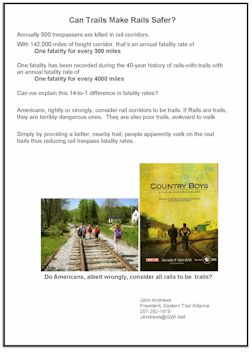|
Each
year we suffer 500 rail corridor trespass fatalities in these United
States. According to Pamela Caldwell Foggin, Federal Railroad
Administration, these fatalities do not include fatalities caused by
vehicles passing rail gates, nor do these 500 fatalities include
suicides.
According
to Betsy Goodrich, New England Office of Rail-to-Trails Conservancy,
there are 142,000 miles of active rail corridor in the United States.
This means 500 fatalities per year per 142,000 miles. Or one trespass
fatality for each 284 mile-years.
Using data provided by Mia Birk, senior author of Rail-with-Trails, Lessons
Learned, we learn that we have 4,400 mile-years of rail-with-trail (RWT) experience in the United States.
If trails do not increase the danger, then we can expect one rail
trespass fatality for every 284 miles per year, then 4,400 mile-year
should result in 15 RWT trespass fatalities since the first RWT was
opened. If trails increase the risk of pedestrian fatalities, then we
might expect many more fatalities. Maybe a ten-fold increase or 150
fatalities in 40 years?
But, have we experienced 150 RWT fatalities? Have we experiences even
15 fatalities? No. In the entire United States, there has never been
one RWT fatality.
My probability professor would not give me a failing grade, if I
claimed adding trails to rail corridors reduced pedestrian fatalities
by 25-to-one.
When I first looked at my math, I felt my math must be wrong. Einstein
once told an acquaintance, “If your math does not match your common
sense, check your math.” I've asked many people to check my math. Many
have rejected my conclusion, but no one has questioned my math.
Click here to view my math tables
|
|
Click on image above for a
higher resolution view of the report cover
(in PDF format)
|
Assuming
the conclusion it valid, or even close to reality, how do we explain
it? This troubled me for months after I first ran the numbers and
looked at the result. It now makes sense, at least to me.
Whenever people trespass in rail corridors, the walking is generally
awful but usually easiest on the rails or rail ties. So kids walk on
the rail ties or rails. College students leaving a pub may choose to
walk an unlit rail corridor to return to their dorm. Hunters seeking
game walk the rails. But, if a well-engineered trail existed beside the
tracks, most would apparently choose the easier path. Therefore, it
does make sense to me that adding a trail to a rail corridor could
reduce fatalities by as much as 25-to-1.
Click here to view Maine Landowner Liability Immunity
information
Rejection
Common wisdom in the rail industry has been that anytime a person
enters a rail corridor the risk of a fatality increases. It's obvious
to experienced railroad employees that adding a trail and inviting
public access should increase the fatalities. Claiming that it will
save lives? Crazy! Reading Steven D. Levitt's Freakonomics inspired me to look at existing rail
fatality data. Why? Because in his book he demonstrates that common
wisdom is often wrong.
Litigation?
Craig Della Penna, well known RWT advocate, asks the rhetorical
question: “Could a railroad be successfully sued if it had refused to
allow a RWT where subsequently a trespass fatality occurred?” A NYC
attorney with railroad litigation experience is interested in the
question. |
